Статьи журнала - International Journal of Image, Graphics and Signal Processing
Все статьи: 1056
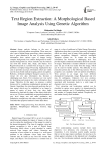
Text Region Extraction: A Morphological Based Image Analysis Using Genetic Algorithm
Статья научная
Image analysis belongs to the area of computer vision and pattern recognition. These areas are also a part of digital image processing, where researchers have a great attention in the area of content retrieval information from various types of images having complex background, low contrast background or multi-spectral background etc. These contents may be found in any form like texture data, shape, and objects. Text Region Extraction as a content from an mage is a class of problems in Digital Image Processing Applications that aims to provides necessary information which are widely used in many fields medical imaging, pattern recognition, Robotics, Artificial intelligent Transport systems etc. To extract the text data information has becomes a challenging task. Since, Text extraction are very useful for identifying and analysis the whole information about image, Therefore, In this paper, we propose a unified framework by combining morphological operations and Genetic Algorithms for extracting and analyzing the text data region which may be embedded in an image by means of variety of texts: font, size, skew angle, distortion by slant and tilt, shape of the object which texts are on, etc. We have established our proposed methods on gray level image sets and make qualitative and quantitative comparisons with other existing methods and concluded that proposed method is better than others.
Бесплатно
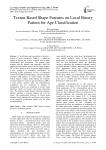
Texton Based Shape Features on Local Binary Pattern for Age Classification
Статья научная
Classification and recognition of objects is interest of many researchers. Shape is a significant feature of objects and it plays a crucial role in image classification and recognition. The present paper assumes that the features that drastically affect the adulthood classification system are the Shape features (SF) of face. Based on this, the present paper proposes a new technique of adulthood classification by extracting feature parameters of face on Integrated Texton based LBP (IT-LBP) images. The present paper evaluates LBP features on facial images. On LBP Texton Images complex shape features are evaluated on facial images for a precise age classification.LBP is a local texture operator with low computational complexity and low sensitivity to changes in illumination. Textons are considered as texture shape primitives which are located with certain placement rules. The proposed shape features represent emergent patterns showing a common property all over the image. The experimental evidence on FGnet aging database clearly indicates the significance and accuracy of the proposed classification method over the other existing methods.
Бесплатно
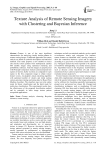
Texture Analysis of Remote Sensing Imagery with Clustering and Bayesian Inference
Статья научная
Texture is one of the most significant characteristics for retrieving visually similar patterns in remote sensing images. Traditional approaches for texture analysis are based on symbolic descriptions and statistical methods. This study proposes a new method to extract and classify texture patterns from multispectral Landsat TM satellite images using optimized clustering and probabilistic inference. After the images are preprocessed with Principal Component Analysis and decomposed into regions of interest, Gabor wavelets are computed for each region in the first component image to obtain texture feature vectors. An adapted k-means clustering algorithm with optimized number of clusters and initial starting centers generates training and testing data for Bayes Point Machine classifiers. The classifiers may run in the online mode for binary classification and the batch mode for multi-class classification. The experimental results show the effectiveness of the proposed classification method and its potentials in other image texture pattern recognition applications.
Бесплатно
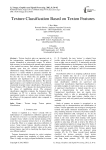
Texture Classification Based on Texton Features
Статья научная
Texture Analysis plays an important role in the interpretation, understanding and recognition of terrain, biomedical or microscopic images. To achieve high accuracy in classification the present paper proposes a new method on textons. Each texture analysis method depends upon how the selected texture features characterizes image. Whenever a new texture feature is derived it is tested whether it precisely classifies the textures. Here not only the texture features are important but also the way in which they are applied is also important and significant for a crucial, precise and accurate texture classification and analysis. The present paper proposes a new method on textons, for an efficient rotationally invariant texture classification. The proposed Texton Features (TF) evaluates the relationship between the values of neighboring pixels. The proposed classification algorithm evaluates the histogram based techniques on TF for a precise classification. The experimental results on various stone textures indicate the efficacy of the proposed method when compared to other methods.
Бесплатно
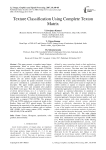
Texture Classification Using Complete Texton Matrix
Статья научная
This paper presents a complete image feature representation, based on texton theory proposed by Julesz’s, called as a complete texton matrix (CTM)for texture image classification. The present descriptor can be viewed as an improved version of texton co-occurrence matrix (TCM) [1] and Multi-texton histogram (MTH) [2]. It is specially designed for natural image analysis and can achieve higher classification rate. TheCTM can express the spatial correlation of textons and can be considered as a generalized visual attribute descriptor. This paper initially quantized the original textures into 256 colors and computed color gradient from RGB vector space. Then the statistical information of eleven derived textons, on a 2 x 2 grid in a non-overlapped manner are computed to describe image features more precisely. To reduce the dimensionality the present paper extended the concept of present descriptor and derived a compact CTM (CCTM). The proposed CTM and CCTM methods are extensively tested on the Brodtaz, Outex and UIUC natural images. The results demonstrate the superiority of the present descriptor over the state-of-art representative schemes such as uniform LBP (ULBP), local ternary pattern (LTP), complete –LBP (CLBP), TCM and MTH.
Бесплатно
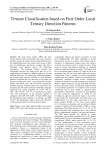
Texture Classification based on First Order Local Ternary Direction Patterns
Статья научная
The local binary pattern (LBP) and local ternary pattern (LTP) are basically gray scale invariant, and they encode the binary/ ternary relationship between the neighboring pixels and central pixel based on their grey level differences and derives a unique code. These traditional local patterns ignore the directional information. The proposed method encodes the relationship between the central pixel and two of its neighboring pixel located in different angles (α, β) with different directions. To estimate the directional patterns, the present paper derived variation in local direction patterns in between the two derivates of first order and derived a unique First order –Local Direction variation pattern (FO-LDVP) code. The FO-LDVP evaluated the possible direction variation pattern for central pixel by measuring the first order derivate relationship among the horizontal and vertical neighbors (0o Vs.90o; 90o Vs. 180o ; 180o Vs.270o ; 270o Vs. 0o) and derived a unique code. The performance of the proposed method is compared with LBP, LTP, LBPv, TS and CDTM using the benchmark texture databases viz. Brodtaz and MIT VisTex. The performance analysis shows the efficiency of the proposed method over the existing methods.
Бесплатно
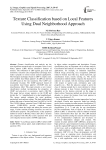
Texture Classification based on Local Features Using Dual Neighborhood Approach
Статья научная
Texture classification and analysis are the most significant research topics in computer vision. Local binary pattern (LBP) derives distinctive features of textures. The robustness of LBP against gray-scale and monotonic variations and computational advantage have made it popular in various texture analysis applications. The histogram techniques based on LBP is complex task. Later uniform local binary pattern’s (ULBP) are derived on LBP based on bit wise transitions. The ULBP’s are rotationally invariant. The ULBP approach treated all non-uniform local binary pattern’s (NULBP) into one miscellaneous label. This paper presents a new texture classification method incorporating the properties of ULBP and grey-level co-occurrence matrix (GLCM). This paper derives ternary patterns on the ULBP and divides the 3 x 3 neighborhood in to dual neighborhood. The ternary pattern mitigates the noise problems particularly near uniform regions. The dual neighborhood reduces the range of texture unit from 0 to 6561 to 0 to 80. The GLCM features extracted from ULBP-dual texture matrix (ULBP-DTM) provide complete texture information about the image and reduce the texture unit range. Various machine learning classifiers are used for classification purpose. The performance of the proposed method is tested on Brodtaz, Outex and UIUC’s textures and compared with GLCM, texture spectrum (TS) and cross-diagonal texture matrix (CDTM) approaches.
Бесплатно
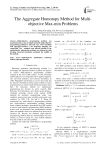
The Aggregate Homotopy Method for Multi-objective Max-min Problems
Статья научная
Multi-objective programming problem was transformed into a class of simple unsmooth single-objective programming problem by Max-min ways. After smoothing with aggregate function, a new homotopy mapping was constructed. The minimal weak efficient solution of the multi-objective optimization problem was obtained by path tracking. Numerical simulation confirmed the viability of this method.
Бесплатно
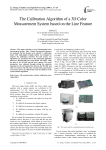
The Calibration Algorithm of a 3D Color Measurement System based on the Line Feature
Статья научная
This paper describes a novel 3 dimensional color measurement system. After 3 kinds of geometrical features are analyzed, the line features were selected. A calibration board with right-angled triangle outline was designed to improve the calibration precision. For this system, two algorithms are presented. One is the calibration algorithm between 2 dimensional laser range finder (2D LRF), while the other is for 2D LRF and the color camera. The result parameters were obtained through solving the constrain equations by the correspond data between the 2D LRF and other two sensors. The 3D color reconstruction experiments of real data prove the effectiveness and the efficient of the system and the algorithms.
Бесплатно
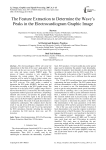
The Feature Extraction to Determine the Wave’s Peaks in the Electrocardiogram Graphic Image
Статья научная
The electrocardiogram (ECG) will create the characteristic in the form of the wave’s peak pattern. The first peak and the next one in one ECG wave have their own value and names, namely PQRST peaks. The process of feature extraction is very significant to determine the certain pattern. The use of feature extraction will be useful to help to detect certain case, including the determination of PQRST peaks according to the ECG print-out. This study makes a method to determine the ECG peaks (PQRST), the heart rate, and ST-deviation according to the ECG graphic image. The input data is in the form of ECG graphic image which is derived from the ECG 12 lead record. This study employs segmentation method (grayscale and binary), morphology (dilation and erosion), and produce the graphic image which is read as the ECG signal in the pre-processing stage, and use the Pan-Tompkins algorithm for the feature extraction method. The result of the peak determination is validated by cardiologists. The validation shows that the result of up and down deflection computation from the isoelectric of each P, Q, R, S, and T wave has represented the ECG calculation clinically; including the calculation to determine the R-R interval, heart rate, and ST-deviation.
Бесплатно
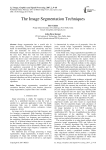
The Image Segmentation Techniques
Статья научная
Image segmentation has a crucial role in image processing. Classical segmentation techniques based on thresholding have been extensively used but they fail drastically for noisy or non-uniformly illuminated images. Several alternatives presented over the time have filled this void but with increased complexity. In this paper we present an algorithm to address the above issues with minimum complexity. We propose normalized self correlation function (NSCF) which forms a basis for the progress of the algorithm. We also introduce relative error function (REF) which is used for qualitative assessment of the algorithm and its comparison with other algorithms. We also propose a second algorithm named piecewise image segmentation (PIS) which is a generalized edge-based method able to generate any desired edge map. The results show that the proposed algorithms are able to perform well for different scenarios and at the same time better than traditional algorithms.
Бесплатно
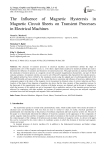
Статья научная
The character of transient processes in electrical machines and transformers defines the shape of magnetization curve of the magnetic circuit, i.e. of its sheets. Approximate analytical or numerical methods are used to determine the influence of saturation and hysteresis on transient processes. This paper presents an analytical method for the calculation of transient process in a magnetic circuit with assumed magnetization characteristic, one part of which contains saturation. An operator calculus was used to solve Maxwell's equations that characterize the transient process. The applied method has been verified by the simulation results using the adapted part of psbxfosaturable.mdl of the MATLAB Simulink software package. It is also shown that due to saturation and influence of hysteresis, additional free components appear in the sheets of the magnetic circuit (recognized in obtained values of current, induction and flux). Analysis of the shape of time diagrams of quantities also shows that the time constants of these quantities increase. In the linear part of the magnetization curve, solutions with higher accuracy are obtained, and in the part of saturation in which the accuracy of the method was not in foreground, only a qualitative analysis of the transient process has been achieved. In comparison with other methods, two regimes of transient processes when given are analyzed: magnetic excitation forces and field strengths, and magnetic fluxes and inductions.
Бесплатно
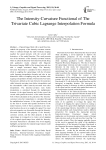
The Intensity-Curvature Functional of The Trivariate Cubic Lagrange Interpolation Formula
Статья научная
A Signal-Image fitted with a model function, embeds the property of the intensity-curvature content, which is defined through the math formulae merging together the signal intensity with the second order derivatives of the model function. This work presents one of the measures of the intensity-curvature content, which is called the Intensity-Curvature Functional along with qualitative results obtained with Magnetic Resonance Imaging (MRI) of the human brain and also with a sample contextual image. The Intensity-Curvature Functional is calculated in three dimensions while re-sampling the signal-image with the trivariate cubic Lagrange interpolation formula and also in two dimensions while re-sampling using the bivariate cubic Lagrange interpolation formula. The Intensity-Curvature Functional is defined as the ratio between the numerator called intensity-curvature term before interpolation and the denominator called intensity-curvature term after interpolation. The intensity-curvature term before interpolation is calculated through the multiplication between: (i) the signal intensity and (ii) the sum of the second order partial derivatives of the model function, both of them calculated at the grid point. The intensity-curvature term after interpolation is calculated through the multiplication between: (i) the signal intensity and (ii) the sum of second order partial derivatives of the model function, both of them calculated at the intra-pixel location chosen to re-sample the signal. Two most relevant properties are discernible through the Intensity-Curvature Functional. One property is the intensity-curvature content, and the other property is that the signal-image is re-imaged so to create a novel mapping of the original signal-image from which the Intensity-Curvature Functional is calculated. The novel mapping highlights and portraits the original image features under a different perspective.
Бесплатно
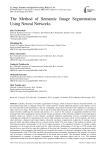
The Method of Semantic Image Segmentation Using Neural Networks
Статья научная
Currently, the means of semantic segmentation of images, which are based on the use of neural networks, are increasingly being used in computer systems for various purposes. Despite significant progress in this industry, one of the most important unsolved problems is the task of adapting a neural network model to the conditions for selecting an object mask in an image. The features of such a task necessitate determining the type and parameters of convolutional neural networks underlying the encoder and decoder. As a result of the research, an appropriate method has been developed that allows adapting the neural network encoder and decoder to the following conditions of the segmentation problem: image size, number of color channels, acceptable minimum segmentation accuracy, acceptable maximum computational complexity of segmentation, the need to label segments, the need to select several segments, the need to select deformed , displaced and rotated objects, allowable maximum computational complexity of training a neural network model, allowable training time for a neural network model. The main stages of the method are related to the following procedures: determination of the list of image parameters to be registered; formation of training example parameters for the neural network model used for object selection; determination of the type of CNN encoder and decoder that are most effective under the conditions of the given task; formation of a representative educational sample; substantiation of the parameters that should be used to assess the accuracy of selection; calculation of the values of the design parameters of the CNN of the specified type for the encoder and decoder; assessment of the accuracy of selection and, if necessary, refinement of the architecture of the neural network model. The developed method was verified experimentally on examples of semantic segmentation of images containing objects such as a car. The obtained experimental results show that the application of the proposed method allows, avoiding complex long-term experiments, to build a NN that, with a sufficiently short training period, ensures the achievement of image segmentation accuracy of about 0.8, which corresponds to the best systems of similar purpose. It is shown that it is advisable to correlate the ways of further research with the development of approaches to the use of special modules such as ResNet, Inception and mechanisms of the Partial convolution type used in modern types of deep neural networks to increase their computational efficiency in the encoder and decoder.
Бесплатно
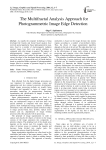
The Multifractal Analysis Approach for Photogrammetric Image Edge Detection
Статья научная
As rapidly the computer technology is being developed the fractals and fractal based analysis have received special popularity. Space photogrammetric snap-shots fixed in a number of electromagnetic radiation spectral ranges have their own special attributes as compared with color images in general. The aspects of photogrammetric images segmentation based on multifractal analysis are studied in this paper in order to extract the edges of the developed object optimally. The aim of the study is to research the way of fractal analysis based on pointwise Hölder exponent of photogrammetric images fixed in a number of spectrum ranges by iconic means of remote sensing.
Бесплатно
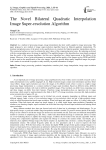
The Novel Bilateral Quadratic Interpolation Image Super-resolution Algorithm
Статья научная
As a method of processing images, image interpolation has been widely applied to image processing. This paper proposed a new method of image super-resolution algorithm based on bilateral quadratic interpolation. We translate interpolation areas of the pixels to the specified area to construct the bilateral quadratic interpolation surfaces. The constructed surfaces are used to estimate the pixel values of the compensating pixel areas. By replacing each pixel with the corresponding areas, the image is amplified. The amplified images of the algorithm have more details remained than the results of the common algorithms. And this novel algorithm has a better improvement in the fidelity of the images. Moreover, it has a better performance in running speed and the quality of the images such as PSNR and SSIM. It can be used on the amplification of the color images, which can provide better quality amplified images for people. And it makes it convenient for people to study carefully on partial information of images.
Бесплатно
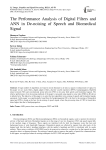
The Performance Analysis of Digital Filters and ANN in De-noising of Speech and Biomedical Signal
Статья научная
A huge number of algorithms are found in recent literature to de-noise a signal or enhancement of signal. In this paper we use: static filters, digital adaptive filters, discrete wavelet transform (DWT), backpropagation, Hopfield neural network (NN) and convolutional neural network (CNN) to de-noise both speech and biomedical signals. The relative performance of ten de-noising methods of the paper is measured using signal to noise ratio (SNR) in dB shown in tabular form. The objective of this paper is to select the best algorithm in de-noising of speech and biomedical signals separately. In this paper we experimentally found that, the backpropagation NN is the best for de-noising of biomedical signal and CNN is found as the best for de-noising of speech signal, where the processing time of CNN is found three times higher than that of backpropagation.
Бесплатно
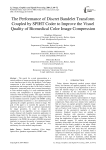
Статья научная
The search for a good representation is a central problem of image processing, this paper explores a new transform type to solve this problem. Color Image compression is now essential for applications such as transmission and storage in data. In the field of medical diagnostics, interested parties have resorted increasingly to color medical imaging. It is well established that the accuracy and completeness of diagnosis are initially connected with the image quality. This paper introduces an algorithm for color medical image compression based on the bandelet transform coupled with SP?HT coding algorithm;bandelet transform is a new method based on capturing the complex geometric content in image. The goal of this paper is to examine the capacity of this transform proposed to offer an optimal representation for image geometric, In order to enhance the compression by our algorithm, we have compared the results obtained with bandelet transform application in satellite image field. For this reason, we evaluated two parameters known for their calculation speed. The first parameter is the PSNR; the second is MSSIM (structural similarity) to measure the quality of compressed image. We concluded that the results obtained are very satisfactory for color medical image domain.
Бесплатно
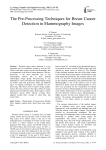
The Pre-Processing Techniques for Breast Cancer Detection in Mammography Images
Статья научная
Presently breast cancer detection is a very important role for worldwide women to save the life. Doctors and radio logistic can miss the abnormality due to inexperience in the field of cancer detection. The pre-processing is the most important step in the mammogram analysis due to poor captured mammogram image quality. Pre-processing is very important to correct and adjust the mammogram image for further study and processing. There are Different types of filtering techniques are available for pre-processing. This filters used to improve image quality, remove the noise, preserves the edges within an image, enhance and smoothen the image. In this paper, we have performed various filters namely, average filter, adaptive median filter, average or mean filter, and wiener filter.
Бесплатно
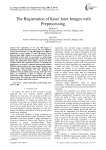
The Registration of Knee Joint Images with Preprocessing
Статья научная
The registration of CT and MR images is important to analyze the effect of PCL and ACL deficiency on knee joint. Because CT and MR images have different limitations, we need register CT and MR images of knee joint and then build a model to do an analysis of the stress distribution on knee joint. In our project, we adopt image registration based on mutual information. In the knee joint images, the information about adipose, muscle and other soft tissue affects the registration accuracy. To eliminate the interference, we propose a combined preprocessing solution BEBDO, which consists of five steps, image blurring, image enhancement, image blurring, image edge detection and image outline preprocessing. We also designed the algorithm of image outline preprocessing. At the end of the paper, an experiment is done to compare the image registration results without the preprocessing and with the preprocessing. The results prove that the preprocessing can improve the image registration accuracy.
Бесплатно

